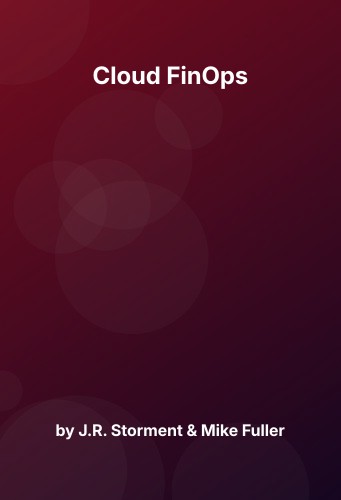Cloud FinOps
Introduction: Financial Operations in a Cloud-First World
“Cloud FinOps” by J.R. Storment and Mike Fuller provides a definitive operating model for managing cloud costs at scale. As cloud adoption accelerates, many enterprises discover that while cloud enables agility and innovation, it can also create uncontrolled spending, opaque usage patterns, and budget overruns.
The FinOps approach treats cloud cost management as a cross-functional capability, involving engineering, finance, and operations teams. Rather than limiting access to cloud resources, FinOps empowers organisations to make smarter, data-informed decisions about usage, performance, and return on investment (ROI).
1. The FinOps Foundation Model
At the heart of the book is the FinOps lifecycle, a three-phase model that guides organisations toward cloud cost maturity:
- Inform – Establish visibility and shared understanding of usage and spend.
- Optimise – Identify waste, improve efficiency, and right-size resources.
- Operate – Embed continuous improvement through governance, automation, and team accountability.
This iterative model aligns with agile and DevOps principles, fostering collaboration across traditionally siloed business units.
2. FinOps Principles and Cultural Mindset
Storment and Fuller outline key principles that distinguish FinOps from traditional IT cost control:
- Teams need to collaborate – Cost is everyone’s responsibility.
- Decisions are driven by business value – Not just raw cost reduction.
- Cloud is dynamic – Real-time data and continuous improvement are essential.
- Accountability must be distributed – Engineering teams are empowered to act on insights.
A central theme of the book is that cloud cost management is not a finance-only function—it requires engineering engagement, metrics instrumentation, and strategic awareness.
3. Core Practices and Capabilities
3A. Cost Allocation and Tagging
Accurate cost allocation is foundational. The book recommends:
- Using tags, labels, and account hierarchies to assign spend to applications, teams, or business units.
- Enforcing tagging policies with automated tools.
- Employing third-party FinOps tools or cloud-native services like AWS Cost Explorer, Azure Cost Management, and GCP Billing.
3B. Budgeting and Forecasting
Cloud spend must be forecasted like any utility. The book offers:
- Techniques for predictive budgeting using historic usage data.
- Best practices for communicating forecasts to leadership.
- Monthly and quarterly “showback” and “chargeback” models to drive accountability.
3C. Optimisation Techniques
Common methods explored include:
- Rightsizing compute (e.g. autoscaling groups, smaller instances).
- Storage lifecycle management (e.g. object tiering).
- Spot instance usage and commitment-based discounts (e.g. AWS Savings Plans, Azure Reservations).
The authors caution that optimising without visibility can backfire—teams must first understand usage patterns before acting.
4. Roles and Collaboration Models
The book identifies key roles within a FinOps team:
- FinOps Lead – Coordinates strategy and execution.
- Product Owners / Engineers – Receive insights and take action.
- Finance Partners – Align budgets and reporting.
- Executives – Use high-level dashboards to support decision-making.
Case studies illustrate successful models where cloud financial accountability is embedded into team workflows, supported by real-time cost reporting dashboards.
5. Real-World Case Studies
The authors draw from the FinOps Foundation’s community of practitioners, showcasing examples like:
- Spotify – Adopted FinOps to unify finance and engineering for daily cost decisions.
- HERE Technologies – Built internal showback tooling and automated anomaly detection.
- Atlassian – Integrated FinOps KPIs into product team OKRs, resulting in significant efficiency gains.
These examples prove that cloud cost optimisation is achievable without sacrificing innovation—when built into team culture.
Key Themes
1. FinOps vs Traditional Cost Management
Where legacy IT finance models were centralised, delayed, and reactive, FinOps is:
- Decentralised and collaborative.
- Real-time and API-driven.
- Integrated with engineering and agile development.
2. The FinOps Tech Stack
The book outlines a “FinOps stack,” including:
- Data Collection: Billing APIs, usage telemetry, resource tags.
- Normalisation: Aligning usage across cloud providers.
- Optimisation Engines: Recommendation tools, automation bots.
- Reporting and Dashboards: BI tools, custom metrics pipelines.
Organisations are encouraged to build modular solutions and avoid tool sprawl.
3. Change Management and Leadership
FinOps adoption often stalls without executive buy-in or cultural shift. The authors stress:
- Starting small with a FinOps pilot.
- Celebrating early wins (e.g. reserved instance savings).
- Building momentum through reporting, gamification, and team empowerment.
4. Metrics that Matter
Useful FinOps KPIs include:
- Cost per customer
- Cost per feature
- Unallocated spend (%)
- Efficiency ratios by team
- Forecast accuracy
These metrics help translate technical actions into business value.
Reflection & Application
Questions to Ask
- Are we treating cloud costs as a shared responsibility across teams?
- Do we have visibility and tagging coverage for all workloads?
- Are we budgeting cloud spend with the same rigour as other resources?
- Can engineers act directly on cost data with confidence?
Steps to Begin or Advance FinOps
- Conduct a visibility audit (tags, accounts, linked billing).
- Appoint a FinOps lead or working group.
- Create a dashboard for showback.
- Establish monthly FinOps reviews with engineering leads.
- Implement optimisation alerts and actions (e.g. idle resources, orphaned volumes).
- Begin forecasting at the team or project level.
Key Takeaway
“Cloud FinOps” turns cost management from a bottleneck into a capability. By shifting cloud cost accountability left—into engineering workflows—organisations gain agility, control, and financial transparency.
In an era of cloud-native, usage-based IT, FinOps is no longer optional. It is a strategic discipline for any enterprise looking to balance innovation with cost efficiency.

